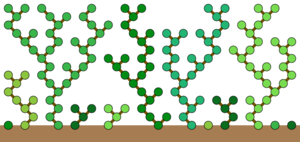Cellular automaton (nonfiction): Difference between revisions
No edit summary |
|||
| Line 19: | Line 19: | ||
== Fiction cross-reference == | == Fiction cross-reference == | ||
* [[Battle Cry of the Cellular Automata]] | |||
* [[Mathematics]] | * [[Mathematics]] | ||
Revision as of 09:26, 28 June 2016
A cellular automaton (pl. cellular automata, abbrev. CA) is a discrete model studied in computability theory, mathematics, physics, complexity science, theoretical biology and microstructure modeling.
Cellular automata are also called cellular spaces, tessellation automata, homogeneous structures, cellular structures, tessellation structures, and iterative arrays.
A cellular automaton consists of a regular grid of cells, each in one of a finite number of states, such as on and off.
The concept was originally discovered in the 1940s by Stanislaw Ulam and John von Neumann while they were contemporaries at Los Alamos National Laboratory.
While studied by some throughout the 1950s and 1960s, it was not until the 1970s and Conway's Game of Life, a two-dimensional cellular automaton, that interest in the subject expanded beyond academia.
In the 1980s, Stephen Wolfram engaged in a systematic study of one-dimensional cellular automata, or what he calls elementary cellular automata; his research assistant Matthew Cook showed that one of these rules is Turing-complete.
In the News
Latest version of Bernoulli family tree powered by cellular automata.
Fiction cross-reference
Nonfiction cross-reference
External links:
- Cellular automaton @ Wikipedia

